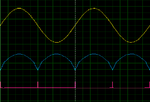ArdyNT
Full Member level 2

- Joined
- Nov 6, 2012
- Messages
- 126
- Helped
- 7
- Reputation
- 14
- Reaction score
- 7
- Trophy points
- 1,298
- Activity points
- 2,304
I just start to build zero crossing detection circuit. I'm using center tap transformer to reduce 220 V AC source.
and here is the screen shoot:


First, is that circuit correct?
Second, can anybody explain how this circuit works? (completely)
Third, when I remove D4, I got nothing (the blue and red in oscilloscope is still a straight line), do you know WHY ?
Thank you very much.
and here is the screen shoot:


First, is that circuit correct?
Second, can anybody explain how this circuit works? (completely)
Third, when I remove D4, I got nothing (the blue and red in oscilloscope is still a straight line), do you know WHY ?
Thank you very much.
